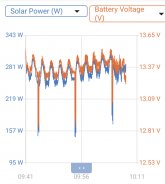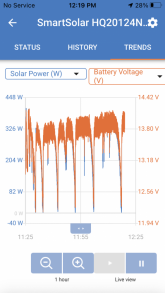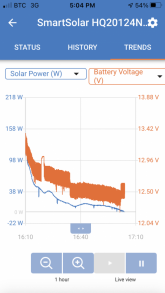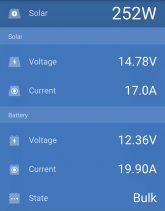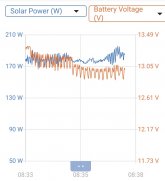This is my first solar installation. Six 150 Watt panels are connected in parallel to a Victron MPPT 100v/50a controller. Ambient temperature is about 75F. I would appreciate any feedback on why the controller’s output cyclically fades away. Is it overheating? The box only shows a steady blue Bulk LED. After the third cycle I pointed a fan at the controller and it seemed to make a slight difference In the duration. Is a cooling fan a common addition to these systems?
Thanks
Thanks
Attachments
-
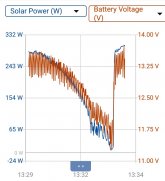 C56D1CEB-F4B3-4FB8-902D-CBF39F4B94F5.jpeg89.8 KB · Views: 22
C56D1CEB-F4B3-4FB8-902D-CBF39F4B94F5.jpeg89.8 KB · Views: 22 -
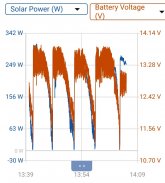 E6F6C690-4F1F-40CC-AAD4-F7EF148EBADA.jpeg94.6 KB · Views: 20
E6F6C690-4F1F-40CC-AAD4-F7EF148EBADA.jpeg94.6 KB · Views: 20 -
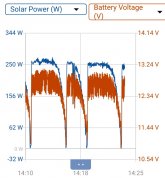 95027860-9F30-4920-BF6E-D38DF318D6AE.jpeg95.8 KB · Views: 20
95027860-9F30-4920-BF6E-D38DF318D6AE.jpeg95.8 KB · Views: 20 -
 8AE3A82B-F41E-4203-83ED-713DEC4ABB72.jpeg102.7 KB · Views: 19
8AE3A82B-F41E-4203-83ED-713DEC4ABB72.jpeg102.7 KB · Views: 19 -
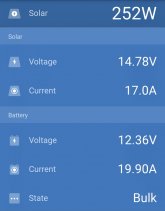 B74F551A-6F04-4029-8B6A-1FAA9C0DC719.jpeg63.4 KB · Views: 21
B74F551A-6F04-4029-8B6A-1FAA9C0DC719.jpeg63.4 KB · Views: 21



